biomimicry
Content
Applying biomimicry: natural principles
 Goal: Understand how to apply biomimicry principles to your design projects, for sustainable product and service development.
Goal: Understand how to apply biomimicry principles to your design projects, for sustainable product and service development.
While most biomimicry points to a specific organism for inspiration, it can be faster and easier to find design strategies in natural principles that other scientists, designers, and engineers have identified.
Life’s Principles
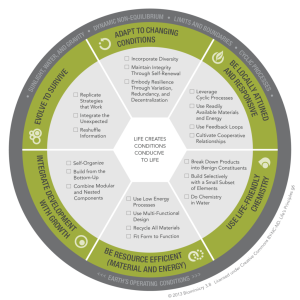
Life’s Principles, from Biomimicry 3.8
People have been practicing biomimicry since before Leonardo DaVinci, so there are many lists of nature’s principles. One such list is the one created by Janine Benyus and others at Biomimicry 3.8, organized into the graphic above. For more details on all of Life’s Principles and how Biomimicry 3.8 uses them in design, see here. A few of the items are explained below, as examples:
Evolving: The central cornerstone of biology, evolution does not plan solutions, but simply tries many things at random and sees what works best, then repeats the process countless times to find an optimized solution. Genetic algorithms are an example of imitating evolution in design. Kevin Kelly describes it as “letting go, with dignity.”1 This means design without authorship–not the traditional process of artists creating their works directly, but creating the right landscape for possibilities to emerge from, like gardeners.
A less sophisticated (but much easier and still useful) example of evolution is Design Thinking’s iterative design process. Design Thinking is making multiple prototypes at once, user-testing them all at once to get feedback on what’s good and bad, then mixing and matching elements to create another generation of prototypes which are in turn user-tested, ad infinitum. This is the type of process that is practiced by design firms like IDEO. By always testing multiple prototypes at once, it helps you not only find better solutions but also helps you find a clearer problem definition.
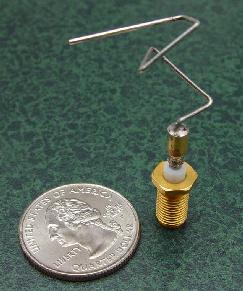
|
This NASA spacecraft antenna owes its odd shape to genetic algorithms, which optimized it in ways a human engineer would never have thought of. (Image from NASA) |
Recycle All Materials, also known as “Waste = Food” in McDonough and Braungart’s book Cradle to Cradle2: This is one of the most important principles for sustainability. It means waste should be treated as a resource to provide more value. Waste can include energy as well, not merely materials. The field of industrial ecology is based on this, creating closed-loop resource flows instead of mines and landfills. Building manufacturing systems with the long-term stability needed for webs of interdependent resource flows can be a challenge. Cradle to Cradle’s concept of biological nutrients and technical nutrients is extremely useful here, as are Design for Lifetime strategies.
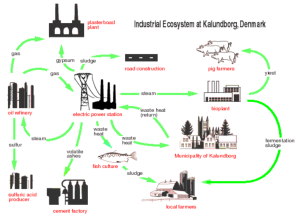
|
The Kalundborg industrial ecosystem has companies, the city, and farmers all connect to turn waste into resources for each other. (image from Botequilha-Leitão, 2012) |
Do chemistry in water, isothermally: This principle (from both Janine Benyus and Steven Vogel3) is fairly self-explanatory. Most industrial chemistry is petroleum-based, happens at high temperatures and/or pressures, and often involves toxics; this makes chemistry highly energy-intensive, potentially hazardous, and dependent on non-renewable resources. Biological chemistry generally happens at ambient temperature (“isothermally”) and ambient pressure, and is water-based. However, it is also extremely complicated, and thus has been hard for industry to understand and use. Chemical and biotech industries are making great strides in this direction, and potential for invention abounds. In the long run, water-based isothermal chemistry should be cheaper as well as greener than today’s industrial chemistry, because of the reduced energy-intensity, reduced safety hazards, and plentiful (renewable) raw materials.
|
Spintex Engineering creates high‑performance biodegradable silk fibers at room temperature from non-toxic materials. (image by Spintex Engineering) |
Be locally attuned and responsive: As Janine Benyus says, organisms are information-driven, with local and timely expertise. Trees change form from summer to winter; many animals change both form and behavior over time. For buildings, this means responding to the moving sun, the seasons, changes in the weather, even changes in occupancy. For products, this means staying useful to different users and different circumstances. This extends product lifetime, and can even allow one product to eliminate the need for others (Which is another strategy in the wheel, Multifunctional Design.)
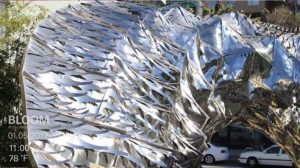
|
A shade structure made of bimetal strips passively adjusts its degree of openness to the temperature, like human skin, for energy-free cooling. See video by Doris Kim Sung (image from the video). |
Build from the bottom up: You can do this on two levels: On the component level, you can build things additively (such as 3D printing, or additive circuit printing) instead of starting with blocks of material that you cut away, or liquids that you mold; or you can use small pre-fab parts that combine to form the whole assembly. This should reduce waste and increase your design flexibility. On the system level, designing from the bottom up means designing networks, not pyramids. The nodes of a system should create the structure of the whole by themselves, through their interrelations. Nature shows this method to be more robust, flexible, and scalable than a system architected from a top-down plan.

|
A hierarchical system (at left) could have one broken link disconnect most of the components; |
.
Other Biological Principles
Other principles of nature not included in the wheel above include:
Cooperate AND compete, not just one or the other: For the first hundred years of biology, most people described Darwinism as a world of harsh and pitiless competition; today’s biologists emphasize the cooperative interdependencies of creatures in their ecosystems. Both are true, and both are useful in their own ways. Dee Hock, the creator of the VISA credit card system, coined the word “chaordic” to describe a partly-chaotic, partly-ordered system where the interdependencies can be both cooperative and competitive at the same time, as they are in natural ecosystems. He structured the VISA system like this, so that many banks could compete with each other chaotically, but there were enough rules to create a playing field they all agreed on.
This phenomenon also appears in hardware and software with open standards: interested parties cooperate to choose arenas (such as a broadcast spectrum or file format) and then compete within that arena, feeling that their cooperation creates a larger total market, saves them money, gives them more robust supply chains, and otherwise provides more benefit than pure competition would.

|
The GSM mobile phone network, while not biomimetic, is an open standard. |
Organize fractally: A fractal is a form or pattern that is similar to itself at multiple levels. This is a way of planning for growth from the bottom up, or detail from the top down. The logarithmic spiral of a snail’s shell did not evolve because it is pretty, but because it allows for perpetual growth without changing shape. When the snail grows to twice its original size, it does not need to tear down walls to expand its house, as most architects would; instead, it just keeps adding more shell in the same shape. Likewise, the extremely detailed and complex shape of a tree can be generated by a very simple branching algorithm. Fractal systems do not need different planning for different scales–it’s all the same. Fractals often do not look exactly alike at different scales, but still have self-similarity.
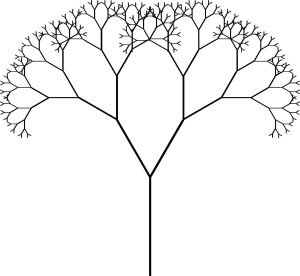
|
A simple way to draw a tree is to draw a Y, and make each top branch a smaller copy of the first Y, and make each of the resulting branches into Y’s, etc. (image by Jeremy Faludi) |
Optimize the system rather than maximizing components: This is general whole-systems-thinking advice, but Benyus points out it is ubiquitous in biology. Organisms always have to trade off multiple dimensions of costs and benefits: greater size comes with a greater need for food and sturdier bones; more leaf area for photosynthesis comes with increased force from wind and rain in storms; etc.
One way to optimize the system is to perform as many functions as possible with as few components as possible. To help you perform this balancing act, you can explicitly list (or better, sketch) all the factors you must balance, to look for synergies. Optimizing the system can achieve what Amory Lovins calls “tunneling through the cost barrier“, where you escape from incremental improvements of individual components to a radical optimization of the whole system. To do this, one component may be made worse to make the whole system better–for instance, “too much” money might be spent on a building’s insulation, but the extra insulation could eliminate the need for a heater, thus saving more money than the extra insulation cost, as well as providing better comfort.
![]()
|
Even a simple leaf performs several tasks: sunlight collection and photosynthesis, water absorption and/or evaporation, withstanding physical stresses of wind and rain, repelling pests, and often more. (image by Jeremy Faludi) |
Design for emergence (swarm): This means designing many small, simple things that work together to become a large sophisticated system. For simplicity, in industry we usually design one function at a time, building separate pieces of hardware or software for each task and then assembling them all together to make the final product. This method has many advantages (such as modularity and easy debugging), but in systems built this way, the whole will just be the sum of its parts. One of the signatures of living systems (and other complex systems) is “emergent phenomena”, where the whole is greater than the sum of its parts. As Kevin Kelly describes it in Out Of Control, an individual bee has a small brain and simple behavior, but combining many bees into a swarm creates a new super-organism with quite sophisticated behavior. Emergent phenomena are difficult (perhaps impossible) to predict analytically, but they can be simulated in virtual worlds.
Designing for emergent phenomena can do much more with less. For instance, Encycle control systems reduce peak electricity use of building HVAC and other equipment; they do not require the cost or administrative attention of a centralized server, because each individual controller coordinates directly with all the other controllers in a method based on how bees swarm. Designing for emergence can also help avoid unintended consequences, such as the suburban sprawl that unexpectedly came from the invention of the automobile. Design for emergence can build robust systems with little material or infrastructure.
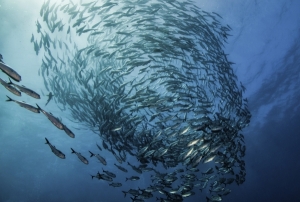
Schools of fish can act like giant super-organisms.
.
TRIZ for Biology
A method of classifying problem-solving principles, called TRIZ, claims there are just 40 methods ever used by any people to innovate new products, buildings, and systems. However, evolution works very differently from human minds. Researchers at the University of Bath extended TRIZ to biology, cataloging and analyzing the many more than 40 methods that nature has used to “invent” new solutions in countless organisms around the world.
They have found there is only a 12% overlap between technology and nature in problem-solving techniques , and “while technology solves problems largely by manipulating usage of energy, biology uses information and structure, two factors largely ignored by technology.” The Bio-TRIZ database is not public, but the researchers are available for consulting. For an overview of this work, see the papers “Biomimetics: its practice and theory” and “TRIZ Evolution Trends in Biological and Technological Design Strategies.”
.
Mechanical Principles
Steven Vogel’s book Cats’ Paws and Catapults contains an excellent list of nature’s design principles for mechanical engineers4. It is reproduced here, with some editing for brevity and links. For more explanation of the principles, see the book.
- “Nature uses fewer flat and more curved surfaces than we do”, for better lightweighting.
- Corners in our technology are abrupt; nature’s are generally rounded, to avoid stress concentrations.
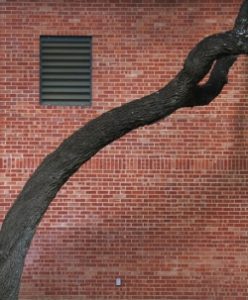
Nature uses curved surfaces and rounded corners
(image by Jeremy Faludi)
- Industry makes things out of many components, each of which is homogeneous; nature makes things out of fewer components but they vary internally.
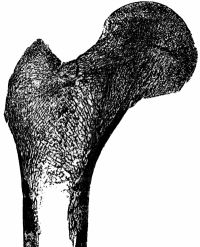
Bone is a single material that varies a great deal in its construction.
(image modified from Wikimedia Commons)
- “Nature’s designs take advantage of diffusion, surface tension, and laminar flow”; we mostly use gravity, thermal conductivity, and turbulence.
- We design for stiffness, nature designs for strength and toughness.
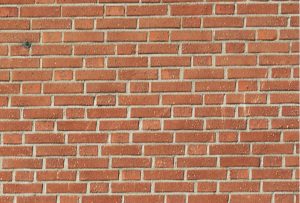
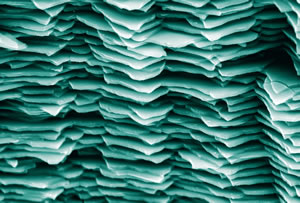
|
Brick walls (left) are generally built for stiffness; abalone shells (right) are like a brick wall in their microstructure, but with flexible “mortar” that makes them twice as strong and a thousand times tougher than their “bricks” alone. (Image Sources 1, 2) |
- Our mechanisms have rigid pieces moving on sliding contacts, “nature’s objects bend, twist, or stretch at predetermined places”.
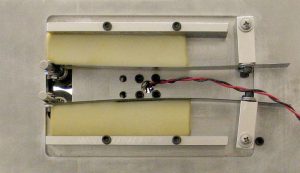
|
This vibration damper for film soundtrack readers replaced $50 of machined arms, high-precision bearings, springs, and air piston with roughly $1.50 of spring steel and viscoelastic foam. (Image and device design by Jeremy Faludi) |
- “We minimize drag with streamlined bodies of fixed shape”, nature uses “nonrigid bodies that reconfigure in flows”.
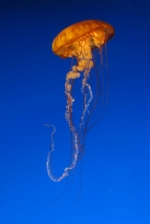
|
Jellyfish are not streamlined rigid bodies; rather, they change their shape to move through water. (image by Jeremy Faludi) |
- Industry uses bulk metals, but nature never does–we use metal’s ductility to avoid crack propagation, while nature uses foams and composites to do so.
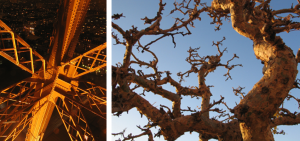
|
The Eiffel Tower uses steel to bend rather than break under stress; trees use wood, a foamed composite, to do the same. (images by Jeremy Faludi) |
- We usually load materials in compression, nature very often loads in tension. (Buckminster Fuller called this “Tensegrity“.)
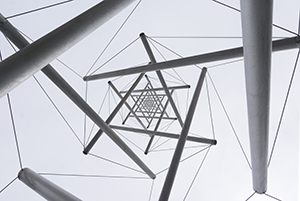
|
Kenneth Snelson’s sculpture “Needle Tower” uses tensegrity for its extremely lightweight form. (image by Jeremy Faludi) |
- “Structures with tensile sheaths outside and pressurized fluid inside are both more common and more diverse in nature’s designs than in ours.” Nature also usually uses water, we usually use a gas.
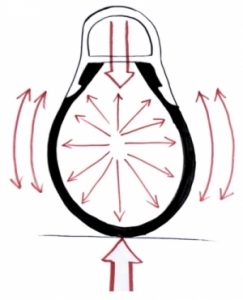
Tires are one of the few places we use fluid pressure to create structure.
(image from Autodesk Sustainability Workshop)
- We use the wheel extensively, nature almost never does.
- Our engines mostly use rotation or expansion, “most of nature’s are based on sliding or contracting”.
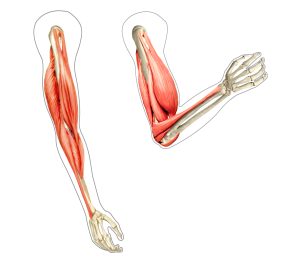 Muscles work by contracting linearly.
Muscles work by contracting linearly.
- “Many of our engines extract energy from temperature differences, whereas all natural engines [such as photosynthesis and the Krebs cycle] are isothermal.”
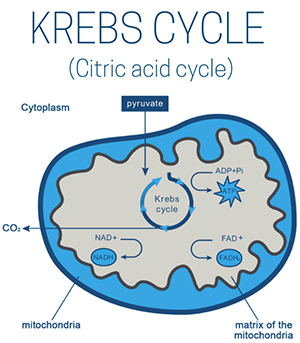
|
The Krebs cycle is how humans and many other organisms turn food into energy in our bodies. It is an isothermal reaction. (Image from BioBrain.com.au.) |
- Nature mostly stores mechanical work as elastic energy, sometimes as gravitational potential energy; we usually store work electrically or kinetically.

|
Kangaroos’ Achilles tendons capture the energy from hitting the ground as elastic energy, and re-release it for the next jump. |
- Our pipes trade off pressure drop for volume of flow, nature hardly ever does.
- We use surface boats, “nature overwhelmingly prefers submarines”.

|
While many birds pass time on the water’s surface, they either fly or dive for serious locomotion. Moving on the surface causes too much drag at high speed. (image from Wikimedia Commons) |
- Nature’s factories often produce things larger, not smaller, than themselves. (e.g. seeds to trees, spiders to their webs, mothers to children).
- Nature’s devices need constant maintenance (but often self-repair).
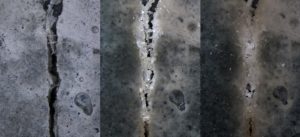
|
A type of concrete invented at TU Delft heals itself after cracking, due to embedded limestone producing bacteria which interact with air and moisture to heal the cracks. (image from AskNature and TU Delft) |
- “Our technology is as dry as nature’s is wet.” (This provides flexibility and toughness, and enables water-based chemistry to perform the growth and constant maintenance of life.)
1 From Out Of Control by Kevin Kelly.
2 See http://en.wikipedia.org/wiki/Cradle-to-cradle_design
3 Vincent, J., Bogatyreva, O., et. al. “Biomimetics: its practice and theory” Journal of the Royal Society Interface 3, no. 9 (2006): 471-482. [PDF]
4 Vogel, S. “Cats’ paws and catapults: mechanical worlds of nature and people” WW Norton & Company, New York, 1998. pp.289-291.
All VentureWell Tools for Design and Sustainability content is shareable and usable by CC BY-NC-SA 4.0 license.
